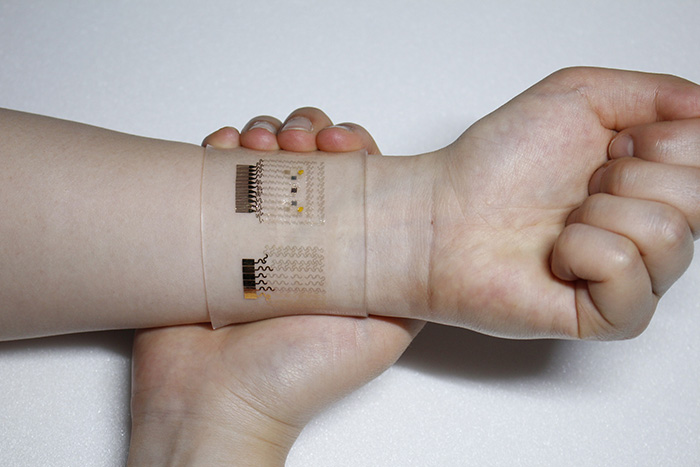A team of Korean researchers has recently developed an electrochemical device that can attach to the skin and control the body's blood sugar levels.
If commercialized, this technology could help relieve the burden born by people with diabetes and by those who have to check their blood sugar levels every day. It would ease the process of taking blood samples several times a day, and help with insulin injections if it's detected that the patient has higher-than-usual blood sugar levels.
This new technology is a graphene-based electrochemical device put together by a research team at the Center for Nanoparticle Research, part of the Institute for Basic Science. The team was led by Professor Kim Dae-Hyeong of Seoul National University’s School of Chemical and Biological Engineering.
Researchers combined an electronic sensor made from a graphene complex and micro-needles. Graphene is a thin layer of carbon atoms. Though thin, it is strong and elastic, and can carry an electrical current. Graphene is 200 times stronger than steel and transfers 100 times more electrical current than copper.

By attaching the device to the skin like a patch, the device can accurately measure blood sugar levels. It analyzes the sugar, temperature, humidity and acid levels of human sweat. When the carbon complex enzyme of the device meets the sugar "melted" inside one's sweat, it changes the electrical current. By monitoring the electrical current, we can measure the blood sugar level. Information about the blood sugar level can then be sent to a mobile device, such as a smartphone.
If a higher level of blood sugar is detected, a medicine that can control blood sugar levels can permeate into the skin through the microneedles. These needles are as small as one millionth of a millimeter. It's coated with a special substance that can "melt" when it's at a temperature warmer than 40 degrees Celsius. When higher blood sugar levels are measured, the coated surface "melts" and the medicine will permeate into the skin.
The research team tested the device by attaching it to human ankles for 24 hours. The results of the blood sugar measurements were the same as results gotten from a blood sugar analyzer used to measure human sweat. The results were also identical with measurements of blood sugar levels checked by collecting the blood directly. The researchers also tested the device on mice with diabetes. They attached the device to mice in order to inject the medicine inside the skin, and witnessed that blood levels decreased.


Professor Kim Dae-Hyeong who leads the research said, “We used graphene, a next-generation material, which enabled us to diagnose, treat and give feedback about diabetes. The technologies used in this device can be used across a wide range of fields, not only measuring blood sugar levels, but also in such things as bio-sensor systems.”
The research results were published at the homepage of Nature Nanotechnology on March 22.
By Yoon Sojung
Korea.net Staff Writer
Photos: Institute for Basic Science, Seoul National University
arete@korea.kr

If commercialized, this technology could help relieve the burden born by people with diabetes and by those who have to check their blood sugar levels every day. It would ease the process of taking blood samples several times a day, and help with insulin injections if it's detected that the patient has higher-than-usual blood sugar levels.
This new technology is a graphene-based electrochemical device put together by a research team at the Center for Nanoparticle Research, part of the Institute for Basic Science. The team was led by Professor Kim Dae-Hyeong of Seoul National University’s School of Chemical and Biological Engineering.
Researchers combined an electronic sensor made from a graphene complex and micro-needles. Graphene is a thin layer of carbon atoms. Though thin, it is strong and elastic, and can carry an electrical current. Graphene is 200 times stronger than steel and transfers 100 times more electrical current than copper.

A user can check their blood sugar levels using a sensor system inside an electrochemical device, dubbed as an electronic skin.
By attaching the device to the skin like a patch, the device can accurately measure blood sugar levels. It analyzes the sugar, temperature, humidity and acid levels of human sweat. When the carbon complex enzyme of the device meets the sugar "melted" inside one's sweat, it changes the electrical current. By monitoring the electrical current, we can measure the blood sugar level. Information about the blood sugar level can then be sent to a mobile device, such as a smartphone.
If a higher level of blood sugar is detected, a medicine that can control blood sugar levels can permeate into the skin through the microneedles. These needles are as small as one millionth of a millimeter. It's coated with a special substance that can "melt" when it's at a temperature warmer than 40 degrees Celsius. When higher blood sugar levels are measured, the coated surface "melts" and the medicine will permeate into the skin.
The research team tested the device by attaching it to human ankles for 24 hours. The results of the blood sugar measurements were the same as results gotten from a blood sugar analyzer used to measure human sweat. The results were also identical with measurements of blood sugar levels checked by collecting the blood directly. The researchers also tested the device on mice with diabetes. They attached the device to mice in order to inject the medicine inside the skin, and witnessed that blood levels decreased.

The newly developed device is highly elastic, as it's made from graphene components. Even if the skin moves around after having the device attached, it can still control blood sugar levels.

Professor Kim Dae-Hyeong leads the research team.
Professor Kim Dae-Hyeong who leads the research said, “We used graphene, a next-generation material, which enabled us to diagnose, treat and give feedback about diabetes. The technologies used in this device can be used across a wide range of fields, not only measuring blood sugar levels, but also in such things as bio-sensor systems.”
The research results were published at the homepage of Nature Nanotechnology on March 22.
By Yoon Sojung
Korea.net Staff Writer
Photos: Institute for Basic Science, Seoul National University
arete@korea.kr

Nano Technology publishes the outcome of the new graphene device on its homepage.
Most popular
- Korea.net welcomes 2025 K-influencers, Honorary Reporters
- 2025 Honorary Reporter class pledges to spread 'real Korea' worldwide
- US urged to exempt tariffs on Korea in first '2+2' trade talks
- 'Gangnam Style,' 'Baby Shark' make YouTube's 2005-25 best list
- Korean culture festival in Cuba marks 1st year of bilateral ties
